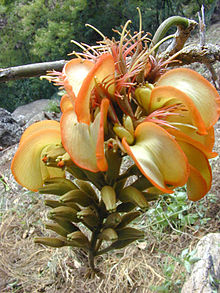
Erythrina is a genus of plants in the pea family, Fabaceae. It contains about 130 species, which are distributed in tropical and subtropical regions worldwide. They are trees, with the larger species growing up to 30 m (98 ft) in height. The generic name is derived from the Greek word ερυθρóς erythros, meaning "red", referring to the flower color of certain species.

Acacia koa, commonly known as koa, is a species of flowering tree in the family Fabaceae. It is endemic to the Hawaiian Islands, where it is the second most common tree. The highest populations are on Hawaiʻi, Maui and Oʻahu.

Charles Gaudichaud-Beaupré was a French botanist.

Hibiscus tiliaceus, commonly known as the sea hibiscus or coast cottonwood, is a species of flowering tree in the mallow family, Malvaceae, with a pantropical distribution along coastlines. It has also been introduced to Florida and New Zealand. It has been debated whether this species is native or introduced to Hawaii.

The Hawaiian tropical rainforests are a tropical moist broadleaf forest ecoregion in the Hawaiian Islands. They cover an area of 6,700 km2 (2,600 sq mi) in the windward lowlands and montane regions of the islands. Coastal mesic forests are found at elevations from sea level to 300 m (980 ft). Mixed mesic forests occur at elevations of 750 to 1,250 m, while wet forests are found from 1,250 to 1,700 m. Moist bogs and shrublands exist on montane plateaus and depressions. For the 28 million years of existence of the Hawaiian Islands, they have been isolated from the rest of the world by vast stretches of the Pacific Ocean, and this isolation has resulted in the evolution of an incredible diversity of endemic species, including fungi, mosses, snails, birds, and other wildlife. In the lush, moist forests high in the mountains, trees are draped with vines, orchids, ferns, and mosses. This ecoregion includes one of the world's wettest places, the slopes of Mount Waiʻaleʻale, which average 373 in (9,500 mm) of rainfall per year.
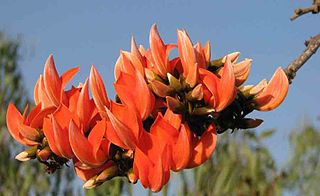
Butea is a genus of flowering plants belonging to the pea family, Fabaceae. It includes five species native to the Indian Subcontinent, Indochina, Tibet, and southern China. It is sometimes considered to have only two species, B. monosperma and B. superba, or is expanded to include four or five.

Charpentiera is a flowering plant genus in the family Amaranthaceae. It consists of five species endemic to Hawaiʻi, where they are known as pāpala, and one species found only on the island of Tubuai in the Austral Islands. All species are trees, some reaching more than 10 metres (33 ft) in height. The genus is named for Arsène Charpentier (1781-1818), professor of pharmacy at Antwerp from 1810 to 1814 and at Cherbourg from 1814 to 1816.

Polyscias racemosa, or false 'ohe, is a species of flowering plant in the family Araliaceae. As Munroidendron racemosum, the species was until recently considered to be the only species in the monotypic genus Munroidendron. With the change in classification, Munroidendron is now obsolete. Polyscias racemosa is endemic to the Hawaiian island of Kauai. It is very rare in the wild and some of its original habitat has been replaced by sugar cane plantations. It was thought for some time to be probably extinct, but was rediscovered a few years prior to 1967.
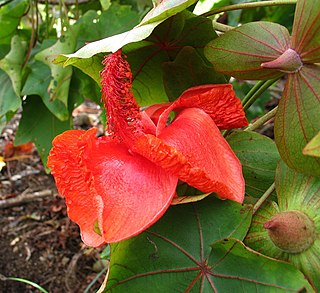
Kokia drynarioides, commonly known as Hawaiian tree cotton, is a species of flowering plant in the mallow family, Malvaceae, that is endemic to the Big Island of Hawaii. It inhabits dry forests at elevations of 455–1,915 m (1,493–6,283 ft). Associated plants include ʻāheahea, ʻaʻaliʻi, hala pepe, wiliwili, uhiuhi, kōlea, ʻaiea, kuluʻī, ʻālaʻa, ʻohe kukuluāeʻo, māmane, and maua. It is threatened by habitat loss and competition with invasive species, such as fountain grass.

Urera is a genus of flowering plants in the nettle family, Urticaceae. It has a pantropical distribution.

Bobea is a genus of flowering plants in the family Rubiaceae. All species in this genus are endemic to Hawaii. Bobea was named for Jean-Baptiste Bobe-Moreau by Charles Gaudichaud-Beaupré in 1830 in his book Voyage de l'Uranie.

Euphorbia haeleeleana, the Kauaʻi spurge, is a species of flowering plant in the croton family, Euphorbiaceae, that is endemic to the islands of Kauaʻi and Oaʻhu in Hawaii. Like other Hawaiian spurges it is known as `akoko.
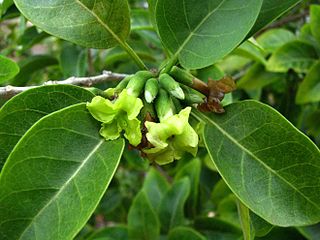
Nothocestrum breviflorum, commonly known as smallflower ʻaiea, is a species of tree in the nightshade family, Solanaceae, that is endemic to the island of Hawaiʻi. It inhabits dry and mixed mesic forests at elevations of 180–1,830 m (590–6,000 ft). These forests are dominated by ʻōhiʻa lehua and koa or lama, while plants associated with smallflower ʻaiea include wiliwili and uhiuhi. N. breviflorum reaches a height of 10–12 m (33–39 ft). It is threatened by habitat loss. It is federally listed as an endangered species of the United States. There are fewer than 50 individuals remaining.
Dracaena konaensis, synonym Pleomele hawaiiensis, the Hawaiʻi hala pepe, is a rare species of flowering plant that is endemic to the island of Hawaiʻi in the state of Hawaii.
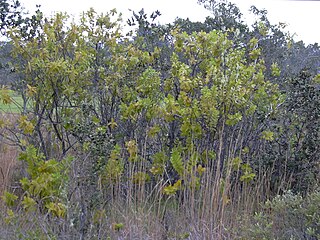
Hawaiian tropical dry forests are a tropical dry broadleaf forest ecoregion in the Hawaiian Islands. They cover an area of 6,600 km2 (2,500 sq mi) on the leeward side of the main islands and the summits of Niʻihau and Kahoʻolawe. These forests are either seasonal or sclerophyllous. Annual rainfall is less than 127 cm (50 in) and may be as low as 25 cm (9.8 in). The rainy season there lasts from November to March.

Psydrax odorata, known as alaheʻe in Hawaiian, is a species of flowering shrub or small tree in the coffee family, Rubiaceae. It is native to the Pacific Islands, New Guinea and Australia.

Senna gaudichaudii, also known by many common names, including kolomana in Hawaii and as blunt-leaved senna in Australia, is a species of flowering plant in the family Fabaceae and is native to some Pacific Islands including Hawaii, parts of Southeast Asia and Queensland in Australia. It is shrub or small tree with pinnate leaves, usually with three to five pairs of oblong to egg-shaped leaflets, and yellow flowers arranged in groups of four to ten, with ten fertile stamens in each flower.
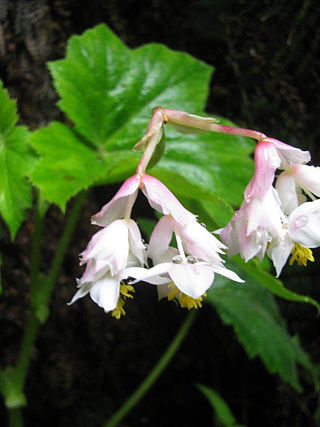
Hillebrandia sandwicensis is a species of a herbaceous perennial flowering plant native to some of the Hawaiian Islands. Common names include ʻakaʻakaʻawa and puʻa maka nui. The genus name honors the German physician William Hillebrand.

Phytolacca sandwicensis, also known as Hawai'i pokeweed, is a member of the Phytolaccaceae family and is a flowering and fruit bearing species endemic to the Hawaiian Islands, where it is found on Kauaʻi, Oʻahu, Molokaʻi, Maui, and Hawaiʻi. Locally it is referred to as pōpolo kū mai and/or pōpolo.Pōpolo itself is a term for any Solanum species, which its berries resemble.

Quadrastichus erythrinae Kim, 2004, is a small parasitoid wasp belonging to the family Eulophidae, but also a secondary phytophage by way of inducing galls on the leaves, stems, petioles and young shoots of various Erythrina species.
